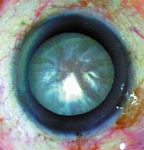Article
Capsular dyes make the extraordinary ordinary
Since the advent of cataract extraction with phacoemulsification, modern cataract surgery has evolved in small incremental steps that have ultimately transformed our technique into its current advanced state. The introduction of foldable IOLs, continuous curvilinear capsulorhexis, topical anesthesia, clear corneal incisions, power modulations, iris hooks, and capsular tension rings are just a handful of the valuable innovations that have made cataract surgery safe and efficacious. I believe that one of the simplest and most indispensable advances to be made in the last several decades has been the introduction of capsular dyes.




The introduction of capsular dyes in the 1990s transformed surgery in these eyes. Capsular dyes have included fluorescein, indocyanine green, gentian violet, methylene blue, and trypan blue.1-5 Trypan blue dye appears to be the standard today because of its safety, low cost, and efficacy.6,7
Enhanced visualization
Capsular dye placed on the anterior capsule under the protection of air or viscoelastic prior to the initiation of the capsulorhexis yields enhanced visualization of the rhexis edge and a greater likelihood for an intact capsulorhexis (Figures 2a and 2b).

Newsletter
Don’t miss out—get Ophthalmology Times updates on the latest clinical advancements and expert interviews, straight to your inbox.




